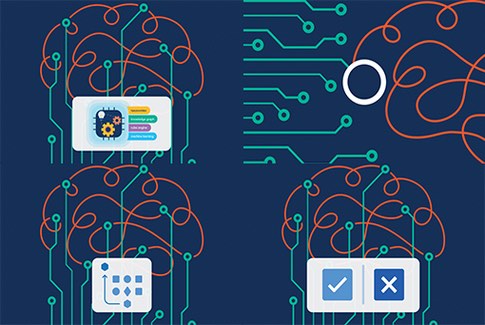
Once considered the technology of the future, artificial intelligence has quickly become a foundational component of the modern enterprise business. In the past four years alone, AI has grown by 270%. As if that was not convincing enough, 93% of US and UK organizations consider AI a business priority. But despite the actual adoption of AI and aspirations to do so, there remain significant barriers to AI entry for the enterprise.
One of the biggest hindrances to AI adoption stems from cost. Two in five executives say that AI technologies and expertise are prohibitively expensive. It is a valid concern when you consider that Microsoft and Nvidia’s high-powered language model was estimated to have cost millions of dollars just to train. That is on top of millions more required throughout the lifecycle of the model. That price tag is a non-starter for most decision makers.
As AI becomes less of a privilege and more of a requirement for the success of the enterprise, the cost to develop a model must be more accessible. Otherwise, small- and mid-sized companies will continue to be priced out of the market. Fortunately, the price barrier is being lowered via hybrid AI. See how this approach is changing the AI landscape.
What Makes AI Development So Costly?
Costly Model Training Process
Training Large Language Models like those from Microsoft or OpenAI is prohibitively expensive. This remains true even after recent reductions in training costs. However, costs to train models still rise rapidly with larger datasets and large companies use billions of parameters for model training purposes. As small- and medium-sized businesses grow, their data likely grows as well, making model training costs more expensive. So, as the enterprise grows, so too does the cost of AI entry, creating a catch-22 that most businesses cannot overcome.
Despite a greater supply of expertise and technology, the training costs still exceed the compute budgets of everyone but major international corporations and world superpowers. When only the wealthiest, most powerful organizations can afford leading technologies, it reinforces inequitable access and keeps prices high for the enterprise.
Complex Tech Stack
While many businesses attempt to minimize their AI investment by building their own models from scratch, this can easily become a more costly approach. Building a model from scratch requires integration of several technologies to reach the same endpoint, so while a company may avoid purchasing a single costly technology, it still invests in multiple less costly ones. In many cases, this becomes a “six of one, half-dozen of another” situation.
Another problem when building models from scratch is the potential siloing of data. Using multiple technologies means different datasets or model parameters reside across different platforms. This causes more churn and waste as employees must spend more time hunting for necessary data across multiple places.
Slow to Market
Traditional open-source AI tools have steep learning curves and are exceedingly difficult to replicate at scale. To leverage these tools, an organization must have skilled talent on staff. Unfortunately, 51% of organizations report a lack of in-house talent as their most significant hurdle to AI adoption.
Not only is finding the right talent a significant recruiting investment, but the talent itself is quite costly as well. As a result, the skills gap and cost of development become reciprocal problems that hamstring efforts for AI adoption.
How a Hybrid AI Platform Mitigates Cost
Flexibility
There is a prevailing idea in the enterprise that “bigger is better.” The enterprise assumes larger datasets, more training parameters, and greater complexity makes for a better model. However, this ultimately leads to higher costs and demands more in-house talent.
Hybrid AI, on the other hand, performs well in situations where little training data or expertise is available. With a hybrid platform, the enterprise can use the data it has available to create an approach for specific use cases. This flexibility eliminates the need to collect massive amounts of data or pursue costly model training procedures.
Hybrid also helps to accelerate processes such as feature engineering, which establishes which information to collect from data to train a machine learning model. A hybrid approach makes feature engineering more efficient and accurate by combining the rule-based logic of symbolic AI with the supervised, automated capabilities of machine learning.
Simplifies Tech Stack
As we’ve touched on previously, implementing AI solutions is a complex endeavor that requires specific skills to execute. Even with the talent and resources devoted to building models from scratch, problems often arise from the need to use multiple technologies to reach a more affordable end goal.
Hybrid AI resolves this problem by managing the complete workflow on a single platform. With intuitive tools and a unified workspace that accommodates all enterprise data, there’s no risk of data becoming siloed or misplaced while training models. Likewise, there is no need to build multiple models for different parts of your organization.
Hybrid AI minimizes technical debt by allowing non-experts to build and deploy a single, comprehensive model that can be replicated across an entire organization. Not only does it resolve the issue of spending on multiple technologies to reach a single end goal, but it accomplishes in a single platform what might otherwise require several.
Bridges the Skills Gap
The skills gap is a significant barrier to AI entry that directly impacts the cost of developing AI models. Unfortunately, the skills gap is not likely to shrink by a noticeable amount anytime soon. However, with the availability of low-code/no-code solutions, companies can bypass the costly investment in highly specialized talent as they begin development. The expert.ai Platform offers exactly this.
With a knowledge graph that provides years of built-in expertise and easy-to-use tools that simplify normally complex tasks, the Platform gives companies a head start when building their AI models. By spending less time establishing knowledge bases and less money acquiring the expertise, companies can deliver value quicker than any traditional method.
The enterprise faces many barriers to AI entry today. But as AI becomes less of a privilege and more of a requirement, the demand for better, more cost-effective solutions will only grow.
A hybrid AI platform can immediately lower development costs by offering more flexible, explainable, and easy-to-use solutions. This combination can help the enterprise immediately overcome multiple barriers to entry at once. Not only is a hybrid solution less expensive but it helps to mitigate the AI skills gap and allows you to better leverage existing talent, thereby saving more money and providing more intuitive tools that have lower maintenance costs going forward.
Interested in learning more about expert.ai’s hybrid AI platform? Check out The Expert Guide to Hybrid Artificial Intelligence.


